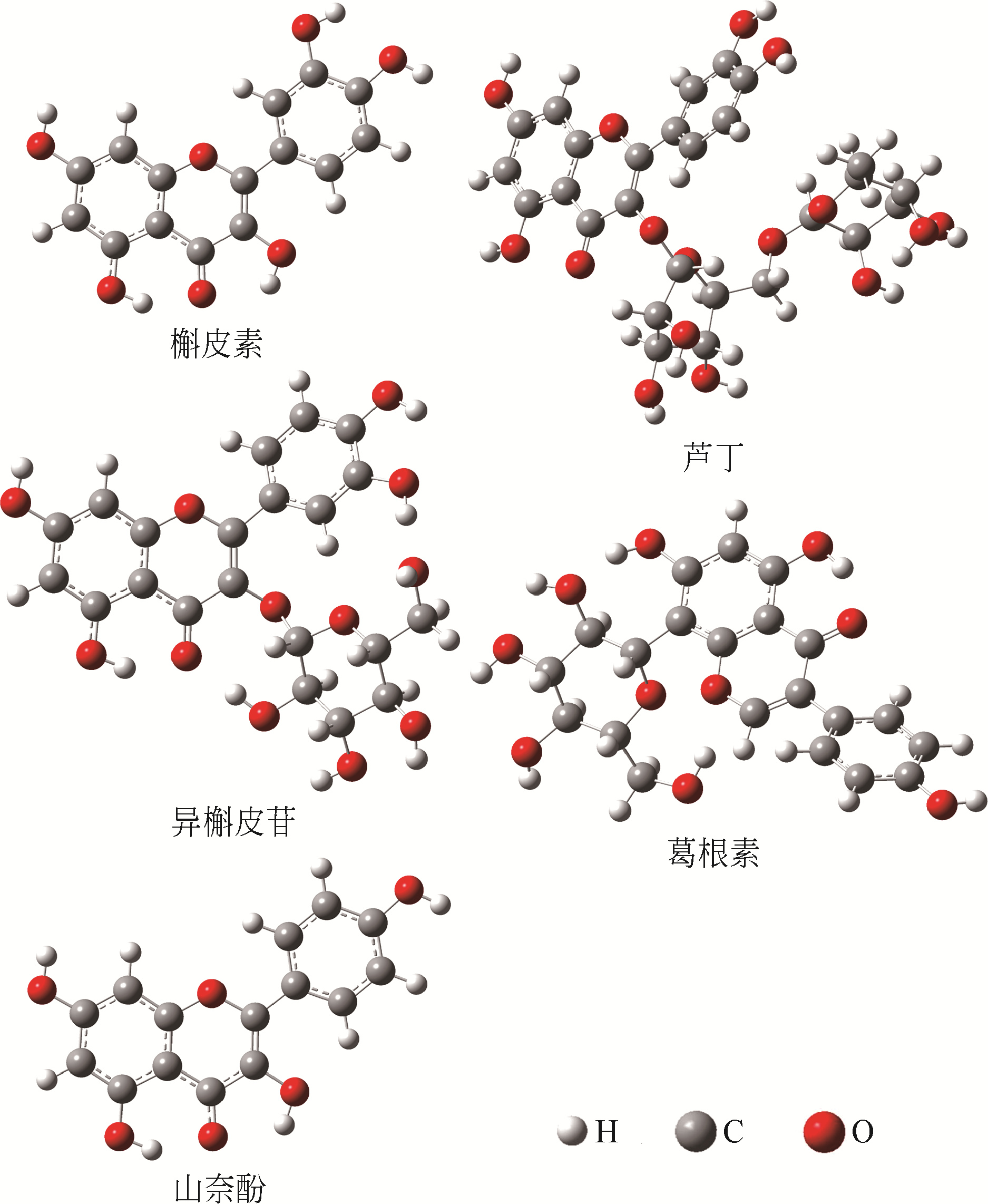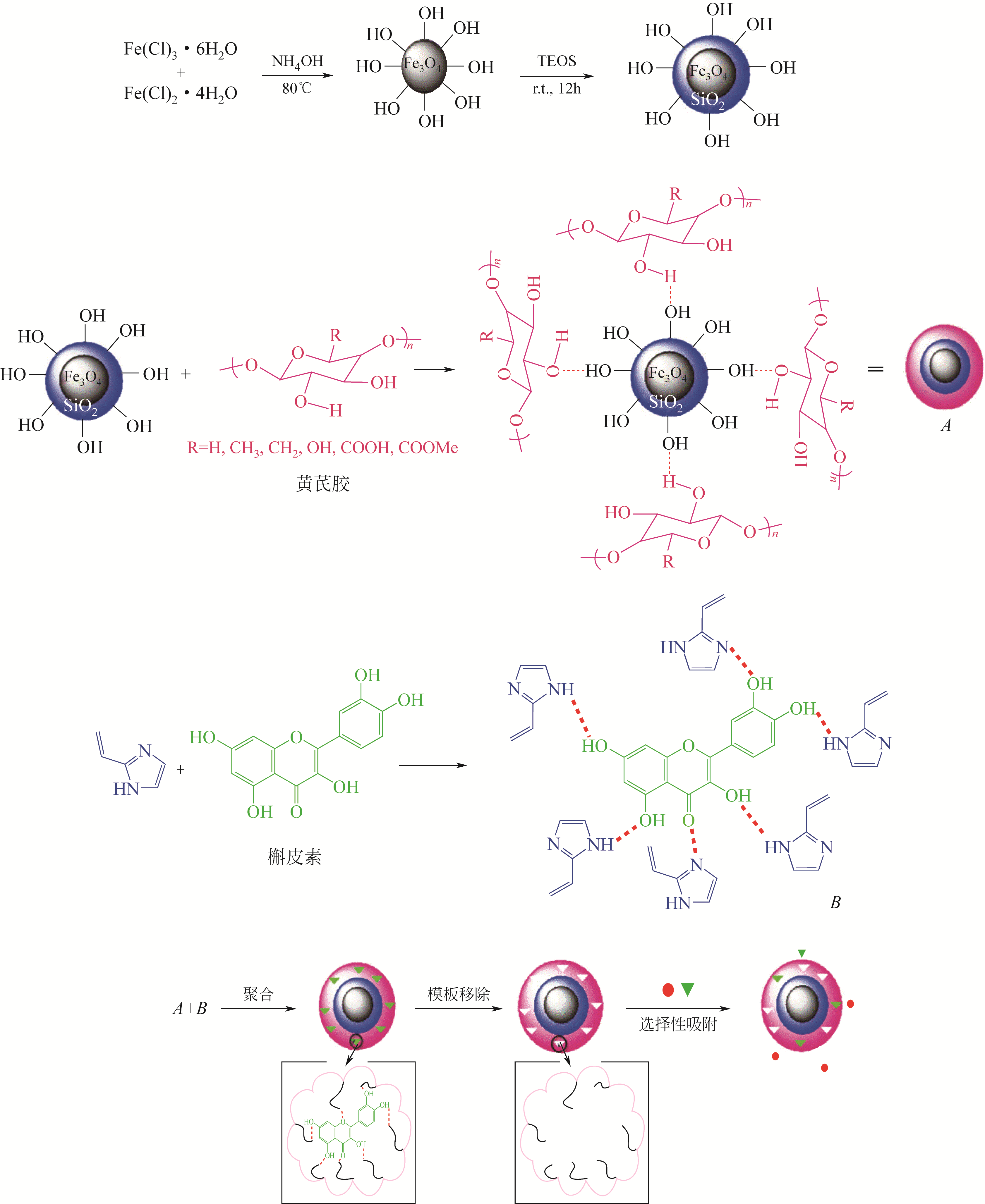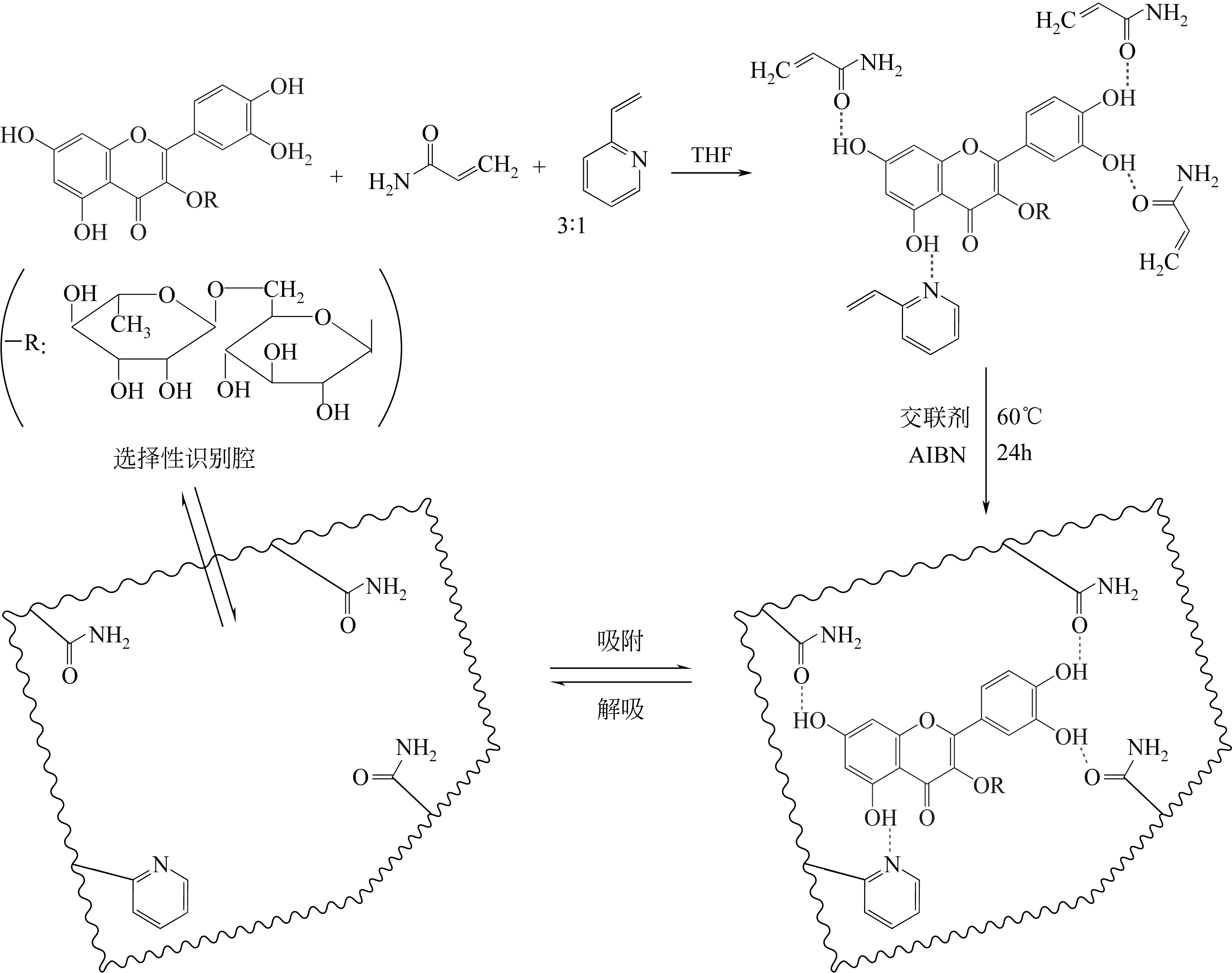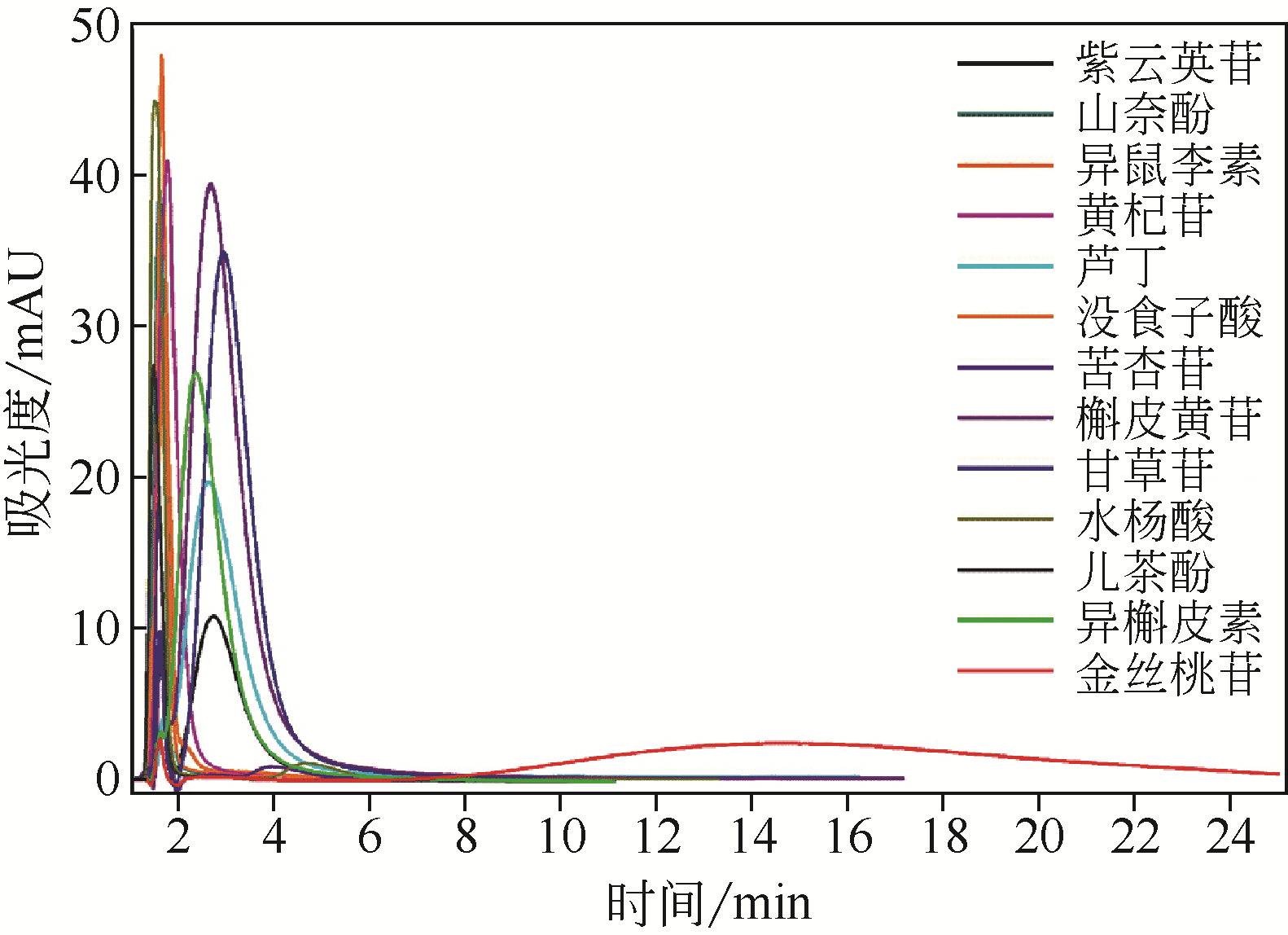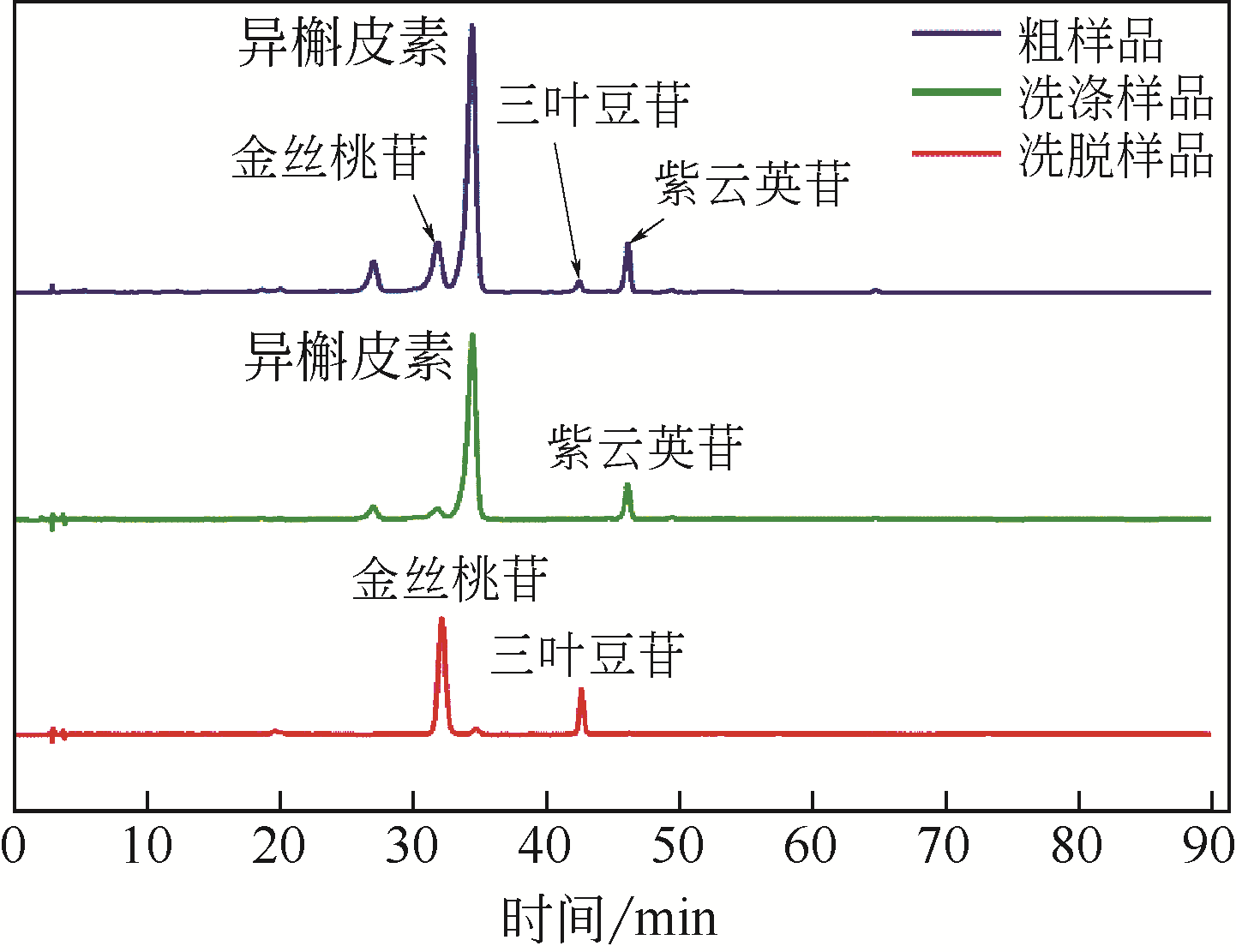化工进展 ›› 2019, Vol. 38 ›› Issue (07): 3365-3376.DOI: 10.16085/j.issn.1000-6613.2018-2278
五种黄酮类分子印迹分离技术研究及应用进展
刘军1,2,任汝全1,2,张燕如1,2,王冰新1,2,秦磊1,2,樊永明1,2
- 1. 北京林业大学材料科学与技术学院,北京 100083
2. 林木生物质化学北京市重点实验室,北京 100083
-
收稿日期:2018-11-21出版日期:2019-07-05发布日期:2019-07-05
Progress in research and application of five kinds of flavonoids molecular imprinting separation technique
Jun LIU1,2,Ruquan REN1,2,Yanru ZHANG1,2,Bingxin WANG1,2,Lei QIN1,2,Yongming FAN1,2
- 1. College of Materials Science and Technology, Beijing Forestry University, Beijing 100083, China
2. Beijing Key Laboratory of Lignocellulosic Chemistry, Beijing 100083, China
-
Received:2018-11-21Online:2019-07-05Published:2019-07-05
摘要:
分子印迹技术用于从复杂的结构类似物混合物中选择性提取黄酮类化合物已经引起近年来的广泛关注。采用传统方法所制备的分子印迹聚合物(MIP)存在诸多缺点,限制了其应用发展。本文主要对5种典型黄酮类化合物(槲皮素、芦丁、异槲皮苷、葛根素、山奈酚)在分子印迹分离方面的研究及应用情况进行综述;对MIP的模拟、合成、表征、应用及优化进行了讨论;采用可逆加成-断裂链转移自由基聚合(RAFT)技术、磁功能化、计算机模拟、优化固相萃取性能参数等措施可以增强MIP印迹结合容量、选择性、传质和分离的程度;指出了开发新单体,引入新聚合方法,提高MIP制备效率,开发大分子检测MIP,使用MIP作为微流体工具,提出合成MIP的新配置,优化MIP的合理设计,探索MIP的大规模合成方法等发展趋势,可为黄酮类化合物及其类似物的分子印迹分离研究提供参考。
中图分类号:
引用本文
刘军, 任汝全, 张燕如, 王冰新, 秦磊, 樊永明. 五种黄酮类分子印迹分离技术研究及应用进展[J]. 化工进展, 2019, 38(07): 3365-3376.
Jun LIU, Ruquan REN, Yanru ZHANG, Bingxin WANG, Lei QIN, Yongming FAN. Progress in research and application of five kinds of flavonoids molecular imprinting separation technique[J]. Chemical Industry and Engineering Progress, 2019, 38(07): 3365-3376.
| 功能单体 | 交联剂 | 引发剂 | 致孔剂或 反应溶剂 | 洗脱溶剂 | 合成方法 | 最大吸附量/mg·g-1 | 表征方法 | 用途 | 文献 |
|---|---|---|---|---|---|---|---|---|---|
| 4-VP | EGDMA | AIBN | THF-MeOH(1∶3) | MeOH-HAc(8∶2) | FTIR, UV | 槲皮素、芦丁、 柚皮素 | [ | ||
| 4-VP | EGDMA | AIBN | THF-MeOH(1∶3) | MeOH-HAc(8∶2) | 原位聚合 | SEM, UV | 槲皮素、芦丁、柚皮素 | [ | |
| AM | EGDMA | 低温光, AIBN | THF-MeOH(1∶3) | MeOH-HAc(9∶1) | 20.17 | FTIR,TEM,NMR,UV | 槲皮素 | [ | |
| MAA | EGDMA | AIBN | THF-MeOH(1∶3) | MeOH-EtOH(9∶1) | SEM,FTIR,UV | 槲皮素 | [ | ||
| MAA,AM,AA,4-VP, 2-VP | EGDMA | AIBN | THF-MeOH(1∶3) | MeOH-HAc(9∶1) | RAFT | 0.46 | SEM,BET,FTIR,HPLC | 维药祖卡木颗粒-槲皮素、山奈酚 | [ |
| 2-VP, MAA, AM | EGDMA | AIBN | CAN, MeOH | MeOH-HAc(9∶1) | 表面印迹 | 32.14 | FTIR,UPLC,HPLC | 白菜-槲皮素、白杨素、绿原酸 | [ |
| NVP, AA | NMBA | H2O2-Vc | MeOH-HAc(9∶1) | 表面印迹 | 29.92 | XRD,TEM,FTIR,VSM,UV | 槲皮素、染料木素 | [ | |
| AM | EGDMA | AIBN | DMK | MeOH-HAc(9∶1) | 0.55 | UV | 槲皮素 | [ | |
| AM | MREGE | AIBN | EA-0.1%SDS | MeOH-HAc(9:∶1) | 悬浮聚合 | 30.65 | SEM,HPLC | 槲皮素、青蒿素、芦丁 | [ |
| 4-VP | EGDMA | AIBN | DMSO | MeOH-HAc(9∶1) | 悬浮聚合 | SEM, UV | 槲皮素 | [ | |
| AM | EGDMA | AIBN | THF | MeOH-HAc(9∶1) | 本体聚合 | 12 | MS,HPLC | 银杏叶-槲皮素、山奈酚 | [ |
| 4-VP | EGDMA | AIBN | DMK | MeOH-HAc(7∶1) | 本体聚合 | 400 | HPLC | 红葡萄酒-槲皮素 | [ |
| 4-VP | EGDMA | AIBN | DMK | MeOH-HAc(7∶1) | 本体聚合 | HPLC | [ | ||
| 4-VP,AM | EGDMA | AIBN | DMK | MeOH-HAc(7∶1) | BET,NMR,HPLC | 槲皮素、桑色素、漆黄素、 儿茶素、芦丁 | [ | ||
| MAA | EGDMA | AIBN | DMF | MeOH-HAc(9∶1) | 0.10 | SEM,HPLC | 槲皮素、异鼠李素 | [ | |
| AM | EGDMA | AIBN | THF, DMK, 1,4-DA, ACN | MeOH-HAc(9∶1) | 0.92 | SEM,FTIR,HPLC | 栎树-槲皮素、芸香苷、儿茶酚 | [ | |
| 4-VP | EGDMA | AIBN | THF, MeOH | MeOH-HAc(8∶2) | 23.77 | TEM,UV | 槲皮素 | [ | |
| AM | EGDMA | AIBN | DMK | MeOH-HAc(9∶1) | 沉淀聚合 | 3.32 | SEM,FTIR | 槲皮素 | [ |
| AM | EGDMA | AIBN | TCM, DMF | MeOH-HAc(9∶1) | 本体聚合 | 2.09 | FTIR,SEM,BET | 槲皮素 | [ |
| 4-VP | EGDMA | AIBN | THF, MeOH | MeOH-HAc(9∶1) | 9.06 | SEM,FTIR,UV,TGA,BET,HPLC | 槲皮素、山奈酚、桑色素 | [ | |
| AM, AA, MMA | NMBA | H2O2-Vc | MeOH, EtOH | SEM,FTIR,UV | 槲皮素 | [ | |||
| 4-VP, MAA | EGDMA, TRIM | AIBN | DMK, CAN, THF | (DMK-ACN(3∶1))- HAc (9∶1) | FTIR,SEM,BET | 儿茶素、 表没食子儿茶素、没食子酸酯、表儿茶素、α-生育酚 | [ | ||
| APTS | TEOS | HAc | MeOH | MeOH-NH3·H2O (19∶1) | 溶胶-凝胶 | 6.45 | SEM,UV | 槲皮素、染料木素 | [ |
| AM | EGDMA | AIBN | THF-MeOH(1∶3) | MeOH-HAc(9∶1) | TEM,FTIR,UV | 槲皮素、芦丁、柚皮素 | [ | ||
| MAA | TRIM | AIBN | MeOH | MeOH-HAc(98∶2) | 表面印迹 | FTIR,HPLC | 枸杞-槲皮素、岩白菜素 | [ | |
| 4-VP | EGDMA | AIBN | THF-H2O-MeOH(6∶3∶1) | MeOH-HAc(9∶1) | 1.03 | FTIR,SEM,TGA, HPLC | 辣木-槲皮素、山萘酚、杨梅素 | [ | |
| AM | EGDMA | AIBN | MeOH, EA | MeOH-HAc(9∶1) | 本体聚合 | FTIR,SEM,NMR,UV | 槲皮素 | [ | |
| AM, IA | EGDMA | AIBN | MeOH | HPLC | 槲皮素、芦丁 | [ | |||
| MAA | NMBA | APS | DMF | NaOH-H2O | 表面印迹 | 98.15 | SEM,FTIR,TGA,HPLC | 槲皮素、芦丁、染料木素 | [ |
| AM | EGDMA | AIBN | THF | MeOH-HAc(9∶1) | 本体聚合, 沉淀聚合, 悬浮聚合 | SEM, TEM,HPLC | 洋葱-槲皮素、柚皮素、大豆苷元、姜黄素 | [ | |
| 4-VP | EGDMA | AIBN | EtOH | MeOH-HAc(17∶3) | 本体聚合 | 1 | UV | 山竹果皮-槲皮素、花青素 | [ |
| AM, 4-VP | EGDMA | AIBN | CAN, DMK | MeOH-HAc(9∶1) | 本体聚合 | HPLC | 啤酒花-槲皮素、芦丁、芸香苷 | [ | |
| 1-VI | GT | CAN-HNO3 | ACN-H2O | MeOH-HAc(1∶1) | RAFT | 175.43 | SEM,VSM,TEM,FTIR,TGA,UV | 槲皮素、儿茶素 | [ |
| AM | EGDMA | Fe2+-K2S2O8-NaHSO3 | H2O-DMSO(4∶1) | MeOH-HAc(9∶1) | 沉淀聚合 | 3.63 | SEM,FTIR,HPLC | 槲皮素、柚皮苷、白杨素 | [ |
| 4-VP, MAA, AM | EGDMA | AIBN | DMK, THF | MeOH-HAc(4∶1) | HPLC | 荨麻-槲皮素、芦丁、儿茶素、咖啡酸、香草酸 | [ | ||
| AM, 4-VP | EGDMA | AIBN | THF-MeOH-H2O (6∶3∶1) | MeOH-HAc(9∶1) | 4.98 | SEM,FTIR,TGA,HPLC | 刺梨皮-槲皮素 | [ | |
| NALA | NMBA | AIBN | MeOH-H2O | MeOH-HAc(7∶3) | 表面印迹 | 26.40 | TEM,FTIR,XPS, HPLC | 红葡萄酒-槲皮素、白杨素、没食子酸 | [ |
表1 槲皮素分子印迹分离研究进展
| 功能单体 | 交联剂 | 引发剂 | 致孔剂或 反应溶剂 | 洗脱溶剂 | 合成方法 | 最大吸附量/mg·g-1 | 表征方法 | 用途 | 文献 |
|---|---|---|---|---|---|---|---|---|---|
| 4-VP | EGDMA | AIBN | THF-MeOH(1∶3) | MeOH-HAc(8∶2) | FTIR, UV | 槲皮素、芦丁、 柚皮素 | [ | ||
| 4-VP | EGDMA | AIBN | THF-MeOH(1∶3) | MeOH-HAc(8∶2) | 原位聚合 | SEM, UV | 槲皮素、芦丁、柚皮素 | [ | |
| AM | EGDMA | 低温光, AIBN | THF-MeOH(1∶3) | MeOH-HAc(9∶1) | 20.17 | FTIR,TEM,NMR,UV | 槲皮素 | [ | |
| MAA | EGDMA | AIBN | THF-MeOH(1∶3) | MeOH-EtOH(9∶1) | SEM,FTIR,UV | 槲皮素 | [ | ||
| MAA,AM,AA,4-VP, 2-VP | EGDMA | AIBN | THF-MeOH(1∶3) | MeOH-HAc(9∶1) | RAFT | 0.46 | SEM,BET,FTIR,HPLC | 维药祖卡木颗粒-槲皮素、山奈酚 | [ |
| 2-VP, MAA, AM | EGDMA | AIBN | CAN, MeOH | MeOH-HAc(9∶1) | 表面印迹 | 32.14 | FTIR,UPLC,HPLC | 白菜-槲皮素、白杨素、绿原酸 | [ |
| NVP, AA | NMBA | H2O2-Vc | MeOH-HAc(9∶1) | 表面印迹 | 29.92 | XRD,TEM,FTIR,VSM,UV | 槲皮素、染料木素 | [ | |
| AM | EGDMA | AIBN | DMK | MeOH-HAc(9∶1) | 0.55 | UV | 槲皮素 | [ | |
| AM | MREGE | AIBN | EA-0.1%SDS | MeOH-HAc(9:∶1) | 悬浮聚合 | 30.65 | SEM,HPLC | 槲皮素、青蒿素、芦丁 | [ |
| 4-VP | EGDMA | AIBN | DMSO | MeOH-HAc(9∶1) | 悬浮聚合 | SEM, UV | 槲皮素 | [ | |
| AM | EGDMA | AIBN | THF | MeOH-HAc(9∶1) | 本体聚合 | 12 | MS,HPLC | 银杏叶-槲皮素、山奈酚 | [ |
| 4-VP | EGDMA | AIBN | DMK | MeOH-HAc(7∶1) | 本体聚合 | 400 | HPLC | 红葡萄酒-槲皮素 | [ |
| 4-VP | EGDMA | AIBN | DMK | MeOH-HAc(7∶1) | 本体聚合 | HPLC | [ | ||
| 4-VP,AM | EGDMA | AIBN | DMK | MeOH-HAc(7∶1) | BET,NMR,HPLC | 槲皮素、桑色素、漆黄素、 儿茶素、芦丁 | [ | ||
| MAA | EGDMA | AIBN | DMF | MeOH-HAc(9∶1) | 0.10 | SEM,HPLC | 槲皮素、异鼠李素 | [ | |
| AM | EGDMA | AIBN | THF, DMK, 1,4-DA, ACN | MeOH-HAc(9∶1) | 0.92 | SEM,FTIR,HPLC | 栎树-槲皮素、芸香苷、儿茶酚 | [ | |
| 4-VP | EGDMA | AIBN | THF, MeOH | MeOH-HAc(8∶2) | 23.77 | TEM,UV | 槲皮素 | [ | |
| AM | EGDMA | AIBN | DMK | MeOH-HAc(9∶1) | 沉淀聚合 | 3.32 | SEM,FTIR | 槲皮素 | [ |
| AM | EGDMA | AIBN | TCM, DMF | MeOH-HAc(9∶1) | 本体聚合 | 2.09 | FTIR,SEM,BET | 槲皮素 | [ |
| 4-VP | EGDMA | AIBN | THF, MeOH | MeOH-HAc(9∶1) | 9.06 | SEM,FTIR,UV,TGA,BET,HPLC | 槲皮素、山奈酚、桑色素 | [ | |
| AM, AA, MMA | NMBA | H2O2-Vc | MeOH, EtOH | SEM,FTIR,UV | 槲皮素 | [ | |||
| 4-VP, MAA | EGDMA, TRIM | AIBN | DMK, CAN, THF | (DMK-ACN(3∶1))- HAc (9∶1) | FTIR,SEM,BET | 儿茶素、 表没食子儿茶素、没食子酸酯、表儿茶素、α-生育酚 | [ | ||
| APTS | TEOS | HAc | MeOH | MeOH-NH3·H2O (19∶1) | 溶胶-凝胶 | 6.45 | SEM,UV | 槲皮素、染料木素 | [ |
| AM | EGDMA | AIBN | THF-MeOH(1∶3) | MeOH-HAc(9∶1) | TEM,FTIR,UV | 槲皮素、芦丁、柚皮素 | [ | ||
| MAA | TRIM | AIBN | MeOH | MeOH-HAc(98∶2) | 表面印迹 | FTIR,HPLC | 枸杞-槲皮素、岩白菜素 | [ | |
| 4-VP | EGDMA | AIBN | THF-H2O-MeOH(6∶3∶1) | MeOH-HAc(9∶1) | 1.03 | FTIR,SEM,TGA, HPLC | 辣木-槲皮素、山萘酚、杨梅素 | [ | |
| AM | EGDMA | AIBN | MeOH, EA | MeOH-HAc(9∶1) | 本体聚合 | FTIR,SEM,NMR,UV | 槲皮素 | [ | |
| AM, IA | EGDMA | AIBN | MeOH | HPLC | 槲皮素、芦丁 | [ | |||
| MAA | NMBA | APS | DMF | NaOH-H2O | 表面印迹 | 98.15 | SEM,FTIR,TGA,HPLC | 槲皮素、芦丁、染料木素 | [ |
| AM | EGDMA | AIBN | THF | MeOH-HAc(9∶1) | 本体聚合, 沉淀聚合, 悬浮聚合 | SEM, TEM,HPLC | 洋葱-槲皮素、柚皮素、大豆苷元、姜黄素 | [ | |
| 4-VP | EGDMA | AIBN | EtOH | MeOH-HAc(17∶3) | 本体聚合 | 1 | UV | 山竹果皮-槲皮素、花青素 | [ |
| AM, 4-VP | EGDMA | AIBN | CAN, DMK | MeOH-HAc(9∶1) | 本体聚合 | HPLC | 啤酒花-槲皮素、芦丁、芸香苷 | [ | |
| 1-VI | GT | CAN-HNO3 | ACN-H2O | MeOH-HAc(1∶1) | RAFT | 175.43 | SEM,VSM,TEM,FTIR,TGA,UV | 槲皮素、儿茶素 | [ |
| AM | EGDMA | Fe2+-K2S2O8-NaHSO3 | H2O-DMSO(4∶1) | MeOH-HAc(9∶1) | 沉淀聚合 | 3.63 | SEM,FTIR,HPLC | 槲皮素、柚皮苷、白杨素 | [ |
| 4-VP, MAA, AM | EGDMA | AIBN | DMK, THF | MeOH-HAc(4∶1) | HPLC | 荨麻-槲皮素、芦丁、儿茶素、咖啡酸、香草酸 | [ | ||
| AM, 4-VP | EGDMA | AIBN | THF-MeOH-H2O (6∶3∶1) | MeOH-HAc(9∶1) | 4.98 | SEM,FTIR,TGA,HPLC | 刺梨皮-槲皮素 | [ | |
| NALA | NMBA | AIBN | MeOH-H2O | MeOH-HAc(7∶3) | 表面印迹 | 26.40 | TEM,FTIR,XPS, HPLC | 红葡萄酒-槲皮素、白杨素、没食子酸 | [ |
| 1 | LIX, CHENX, SUNG, et al. Green synthesis and evaluation of isoquercitrin imprinted polymers for class-selective separation and purification of flavonol glycosides[J]. Analytical Methods, 2015, 7(11): 4717-4724. |
| 2 | LIX, JIAM, ZHAOY, et al. Preparation of phenylboronate affinity rigid monolith with macromolecular porogen[J]. Journal of Chromatography A, 2016, 1438: 171-178. |
| 3 | CAIP, ZHAOY, YANGT, et al. Preparation of magnetic molecularly imprinted polymers for selective isolation and determination of kaempferol and protoapigenone in Macrothelypteris torresiana[J]. Journal of Huazhong University of Science and Technology, 2014, 34(6): 845-855. |
| 4 | CHENL, JIAX, LUQ, et al. Highly efficient and selective enrichment of puerarin from Radix Puerariae by molecularly imprinted solid-phase extraction[J]. Separation and Purification Technology, 2010, 71(3): 324-330. |
| 5 | LIJ, LUJ, QIAOX, XUZ. A study on biomimetic immunoassay-capillary electrophoresis method based on molecularly imprinted polymer for determination of trace trichlorfon residue in vegetables[J]. Food Chemistry, 2017, 221: 1285-1290. |
| 6 | PARDOA, MESPOUILLEL, BLANKERTB, et al. Quercetin-imprinted chromatographic sorbents revisited: optimization of synthesis and rebinding protocols for application to natural resources[J]. Journal of Chromatography A, 2014, 1364: 128-139. |
| 7 | GUPTAV K, YOLAM L, ATARN. A novel molecular imprinted nanosensor based quartz crystal microbalance for determination of kaempferol[J]. Sensors and Actuators B: Chemical, 2014, 194: 79-85. |
| 8 | LOPEZ MARIAd M C, PEREZM.C. C, GARCIA MARIA S D,et al. Preparation, evaluation and characterization of quercetin-molecularly imprinted polymer for preconcentration and clean-up of catechins[J]. Analytica Chimica Acta, 2012, 721: 68-78. |
| 9 | YANGL, YANGJ, XUB, et al. Facile preparation of molecularly imprinted polypyrrole-graphene-multiwalled carbon nanotubes composite film modified electrode for rutin sensing[J]. Talanta, 2016, 161: 413-418. |
| 10 | 买买提·吐尔逊, 古丽巴哈尔·达吾提, 热萨莱提·伊敏, 等. 基于活性自由基聚合的槲皮素分子印迹聚合物的合成及在维药祖卡木颗粒活性成分分析中的应用[J]. 高等学校化学学报, 2015, 36(12): 2402-2408. |
| TURSONM, DAWUTG, EMINR, et al. Preparation of quercetin imprinted polymer by living radical polymerization and its application in the composition analysis of Zukamu Granules for uighur medicine[J]. Chemical Journal of Chinese Universities, 2015, 36(12): 2402-2408. | |
| 11 | HEMMATIK, MASOUMIA, GHAEMYM. Tragacanth gum-based nanogel as a superparamagnetic molecularly imprinted polymer for quercetin recognition and controlled release[J]. Carbohydrate Polymers, 2016, 136: 630-640. |
| 12 | LIUR M, GUIL, DAIS F, et al. Quercetin molecularly imprinted polymers and its application in the separation and analysis of natural products [J]. Advanced Materials Research, 2015, 1083: 46-50. |
| 13 | 范培民, 王兵. 槲皮素金属配位分子印迹聚合物的识别性能[J]. 高等学校化学学报, 2009, 30(12): 2514-2520. |
| FANPeimin, WANGBing. Molecular recognition characteristics of quercetin’s metal-complexing imprinted polymer[J]. Chemical Journal of Chinese Universities, 2009, 30(12): 2514-2520. | |
| 14 | 范培民,王兵. 槲皮素金属配位印迹聚合物膜的制备及性能研究[J]. 化学学报, 2010, 68(24): 2543-2550. |
| FANPeimin, WANGBing. Preparation of quercetin’s metal-complexing imprinted polymer membrane and its properties[J]. Acta Chimica Sinica, 2010, 68(24): 2543-2550. | |
| 15 | 李鸣芳, 王兵. 合成引发方式对槲皮素-钴(Ⅱ)配位印迹聚合物结构与性能的影响[J]. 化学学报, 2012, 70(7): 921-928. |
| LIMingfang, WANGBing. Synthesis approach of initiation mode impacting on the structure and properties of metal-complexing imprinted polymers for quercetin-Co(Ⅱ) [J]. Acta Chimica Sinica, 2012, 70(7): 921-928. | |
| 16 | 贾宝秀, 谷志亮, 李玉琴, 等. 槲皮素-铝配位分子印迹聚合物的制备及其结合特性研究[J]. 中国现代应用药学, 2014, 31(1): 17-22. |
| JIABaoxiu, GUZhiliang, LIYuqin, et al. Preparation of quercetin-Al(Ⅲ) complex molecularly imprinted polymer and its binding characteristics[J]. Chinese Journal of Modern Applied Pharmacy, 2014, 31(1): 17-22. | |
| 17 | 苏立强, 李继姣, 高源. 槲皮素表面分子印迹聚合物的制备及其应用研究[J]. 化学通报, 2016, 79(4): 349-354. |
| SULiqiang, LIJijiao, GAOYuan. Preparation and application of quercetin molecularly imprinted polymer[J]. Chemistry Bulletin, 2016, 79(4): 349-354. | |
| 18 | 阮永欣, 马应霞, 王茹娟, 等. 槲皮素磁性分子印记聚合物的制备及其吸附性能[J]. 功能高分子学报, 2016, 29(1): 68-74. |
| RUANYongxin, YingxiaMA, WANGRujuan, et al. Preparation and adsorption property of quercetin magnetic molecularly imprinted polymers[J]. Journal of Founctional polymers, 2016, 29(1): 68-74. | |
| 19 | 赵丹丹, 陈盛余, 史兵方, 等. 槲皮素分子印记聚合物的合成条件研究[J]. 广东化工, 2016, 43(8): 32-33. |
| ZHAODandan, CHENShengyu, SHIBingfang, et al. Study of polymerization conditions for molecularly imprinted polymers using quercetin as template[J]. Guangdong Chemical Industry, 2016, 43(8): 32-33. | |
| 20 | 周菊英, 张玲玉, 李鹏飞,等. 以马来松香丙烯酸乙二醇酯为交联剂的分子印迹聚合物对槲皮素的选择吸附性能[J]. 精细化工, 2016, 33(3): 314-319. |
| ZHOUJuying, ZHANGLingyu, LIPengfei, et al. Selecting sorption properties of quercetin molecularly imprinted polymer with ethylene glycol maleic rosinate acrylate as the linking agent[J]. Fine Chemicals, 2016, 33(3): 314-319. | |
| 21 | 谭微, 蔡锦源, 蒋潮, 等. 槲皮素和不同功能单体的分子印迹识别性能研究[J]. 应用化工, 2018, 43(3): 614-617. |
| TANWei, CAIJinyuan, JIANGChao, et al. Study of molecularly imprinted recognition properties of quercetin with different functional monomers[J]. Applied Chemical Industry, 2018, 43(3): 614-617. | |
| 22 | XIEJ, ZHUL, LUOH, et al. Direct extraction of specific pharmacophoric flavonoids from gingko leaves using a molecularly imprinted polymer for quercetin[J]. Journal of Chromatography A, 2001, 934: 1-11. |
| 23 | MOLINELLIA, WEISSR, MIZAIKOFFB. Advanced solid phase extraction using molecularly imprinted polymers for the determination of quercetin in red wine[J]. Journal of Agricultural and Food Chemistry, 2002, 15: 1804-1808. |
| 24 | MOLINELLIA, JANOTTAM, MIZAIKOFFB. Molecularly imprinted polymers for biomolecular recognition[J]. Methods in Molecular Biology, 2005, 300: 243-254. |
| 25 | O’MAHONYJ, MOLINELLIA, NOLANK, et al. Anatomy of a successful imprint: analysing the recognition mechanisms of a molecularly imprinted polymer for quercetin[J]. Biosensors and Bioelectronics, 2006, 21(7): 1383-1392. |
| 26 | XIAY, GUOT, SONGM, et al. Selective separation of quercetin by molecular imprinting using chitosan beads as functional matrix[J]. Reactive and Functional Polymers, 2006, 66(12): 1734-1740. |
| 27 | SONGX, LIJ, WANGJ, CHENL. Quercetin molecularly imprinted polymers: preparation, recognition characteristics and properties as sorbent for solid-phase extraction[J]. Talanta, 2009, 80(2): 694-702. |
| 28 | FANP, WANGB. Regulatory effects of Zn(Ⅱ) on the recognition properties of metal coordination imprinted polymers[J]. Journal of Applied Polymer Science, 2010, 116(1): 258-266. |
| 29 | QIUH, LUOC, FANL, et al. Molecularly imprinted polymer prepared by precipitation polymerization for quercetin[J]. Advanced Materials Research, 2011, 306/307: 646-648. |
| 30 | YUL, YUNY, ZHANGW. Preparation, recognition characteristics and properties for quercetin molecularly imprinted polymers[J]. Desalination and Water Treatment, 2011, 34(1/2/3): 309-314. |
| 31 | PAKADEV, LINDAHLS, CHIMUKAL, et al. Molecularly imprinted polymers targeting quercetin in high-temperature aqueous solutions[J]. Journal of Chromatography A, 2012, 1230: 15-23. |
| 32 | CHENZ, WANGM, FUY, et al. Preparation of quercetin molecularly imprinted polymers[J]. Designed Monomers and Polymers, 2012, 15(1): 93-111. |
| 33 | YANGP, HOUW D, QIUH D, et al. Preparation of quercetin imprinted core-shell organosilicate microspheres using surface imprinting technique[J]. Chinese Chemical Letters, 2012, 23: 615-618. |
| 34 | HUANGFUF, WANGB, LIM. Synthesis and evaluation of a metal-complexing imprinted polymer for Chinese herbs quercetin[J]. Journal of Applied Polymer Science, 2012, 126(2): 501-509. |
| 35 | HONGY, CHENL. Extraction of quercetin from Herba Lysimachiae by molecularly imprinted-matrix solid phase dispersion[J]. Journal of Chromatography B, 2013, 941: 38-44. |
| 36 | PAKADEV, CUKROWSKAE, LINDAHLS, et al. Molecular imprinted polymer for solid-phase extraction of flavonol aglycones from Moringa oleifera extracts[J]. Journal of Separation Science, 2013, 36(3): 548-555. |
| 37 | VERMAN, TREHANN. Synthesis and characterization of molecularly imprinted polymers for quercetin[J]. Journal of Biomimetics, Biomaterials and Tissue Engineering, 2013, 17: 71-78. |
| 38 | TREHANN, KAURS, KAURB, et al. Effect of monomer on the synthesis of molecularly imprinted polymers for quercetin[J]. International Research Journal of Pharmaceutical and Applied Sciences (IRJPAS), 2013, 3(5): 19-25. |
| 39 | GAOB, ZHANGY, CHENT. Designing and preparing of quercetin surface-imprinted material and its molecular recognition characteristics[J]. Journal of Applied Polymer Science, 2014, 131(22): 547-557. |
| 40 | PIACHAMT, ISARANKUR-NA-AYUDHYAC, PRACHAYASITTIKULV. Quercetin-imprinted polymer for anthocyanin extraction from mangosteen pericarp[J]. Materials Science and Engineering C, 2015, 51: 127-131. |
| 41 | KRNANOVAJ, DENDERZN, LEHOTAYJ, et al. Determination of some flavonoids by HPLC using quercetin-molecularly imprinted polymers[J]. Journal of Liquid Chromatography & Related Technologies, 2015, 38(6): 702-708. |
| 42 | NASSERI I, ALGIERIC, GAROFALOA,et al. Hybrid imprinted membranes for selective recognition of quercetin[J]. Separation and Purification Technology, 2016, 163: 331-340. |
| 43 | ERSOYS K, TUTEME, BASKANK S, et al. Preparation, characterization and usage of molecularly imprinted polymer for the isolation of quercetin from hydrolyzed nettle extract[J]. Journal of Chromatography B, 2016, 1017/1018: 89-100. |
| 44 | PAKADEV E, MOLEFEE D, TAVENGWAN T. Quantitative determination of trace concentrations of quercetin from prickly pear skin complex sample extracts by application of molecularly imprinted polymers[J]. Journal of Environmental Chemical Engineering, 2017, 5(1): 1186-1195. |
| 45 | ZENGINA, BADAKM U, AKTASN. Selective separation and determination of quercetin from red wine by molecularly imprinted nanoparticles coupled with HPLC and ultraviolet detection[J]. Journal of Separation Science, 2018, 41(17): 3459-3466. |
| 46 | 马甲民, 许可, 黄海兰, 等. 新型磁性分子印迹聚合物的合成及吸附性能研究[J]. 化学试剂, 2014, 36(3): 201-204. |
| JiaminMA, XUKe, HUANGHailan, et al. Synthesis and adsorption properties of a novel magnetic molecularly imprinted polymer[J]. Chemical Reagents, 2014, 36(3): 201-204. | |
| 47 | PENGL, WANGY, ZENGH, et al. Molecularly imprinted polymer for solid-phase extraction of rutin in complicated traditional Chinese medicines[J]. Analyst, 2011, 136(4): 756-763. |
| 48 | ZENGH, WANGY, NIEC, et al. Preparation of magnetic molecularly imprinted polymers for separating rutin from Chinese medicinal plants[J]. Analyst, 2012, 137(10): 2503-2512. |
| 49 | 王素素, 张月, 李辉, 等. 芦丁-槲皮素双模板印迹聚合物的制备、表征及识别[J]. 应用化学, 2015, 32(11): 1290-1298. |
| WANGSusu, ZHANGYue, LIHui, et al. Preparation, characterization and recognition behavior of quercetin-rutin bi-template molecularly imprinted polymers[J]. Chinese Journal of Applied Chemistry, 2015, 32(11): 1290-1298. | |
| 50 | 成洪达, 邢占芬, 张平平. 芦丁-Cu2+配位印迹聚合物的制备与吸附作用研究[J]. 中草药, 2015, 46(24): 3666-3669. |
| CHENGHongda, XINGZhanfen, ZHANGPingping. Preparation of rutin-Cu2+ complex imprinted polymer and its adsorption character[J]. Chinese Traditional and Herbal Drugs, 2015, 46(24): 3666-3669. | |
| 51 | 孙锦秀, 杨翠云, 谢金润, 等. 黄酮类分子印迹互穿聚合物网络水凝胶的制备及性能研究[J]. 实用药物与临床, 2016, 19(6): 743-745. |
| SUNJinxiu, YANGCuiyun, XIEJinrun, et al. Preparation and properties of interpenetrating polymer network hydrogels for molecularly imprinting of flavonoids [J]. Practical Pharmacy and Clinical Remedies, 2016, 19(6): 743-745. | |
| 52 | 杨云裳, 常玉枝, 张应鹏, 等. 芦丁分子印迹聚合物的制备及其吸附性能的研究[J]. 食品工业科技, 2012, 33(2): 119-121. |
| YANGYunshang, CHANGYuzhi, ZHANGYingpeng, et al. Study on preparation and performance of rutin molecularly imprinted polymers[J]. Science and Technology of Food Industry, 2012, 33(2): 119-121. | |
| 53 | FUY, CHENZ, YUH, et al. Preparation and adsorption selectivity of rutin molecularly imprinted polymers[J]. Journal of Applied Polymer Science, 2012, 123(2): 903-912. |
| 54 | ZENGH, WANGY, LIUX, et al. Preparation of molecular imprinted polymers using bi-functional monomer and bi-crosslinker for solid-phase extraction of rutin[J]. Talanta, 2012, 93: 172-181. |
| 55 | MA W, TANGB, ROW K H. Exploration of a ternary deep eutectic solvent of methyltriphenylphosphonium bromide/chalcone/formic acid for the selective recognition of rutin and quercetin in Herba Artemisiae Scopariae[J]. Journal of Separation Science, 2017, 40(16): 3248-3256. |
| 56 | WULFFG. Enzyme-like catalysis by molecularly imprinted polymers[J]. Chemical Reviews, 2002, 102(1): 1-27. |
| 57 | 许苗苗, 王素素, 李辉, 等. 沉淀聚合法制备葛根素印迹微球及其固相萃取葛根粉[J]. 食品科学, 2015, 36(10): 11-15. |
| XUMiaomiao, WANGSusu, LIHui, et al. Preparation of puerarin-imprinted polymer microspheres by precipitation polymerization technique for use in solid phase extraction of flavonoids from pueraria root powder[J]. Food Science, 2015, 36(10): 11-15. | |
| 58 | 陈立娜, 都述虎, 陆庆, 等. 葛根素高选择性分子印迹聚合物的制备及其亲合性评价[C]// 全国中药商品学术大会, 2008: 450-457. |
| CHENLina, DUShuhu, LUQing, et al. Preparation and affinity evaluation of puerarin highly selective molecularly imprinted polymer[C]// National Traditional Chinese Medicine Commodity Conference, 2008: 450-457. | |
| 59 | QINP, YANGJ, KARIMM N. Characterization and selectivity studies of molecular imprinted membranes of Puerarin using scanning electron microscopy[J]. Scanning, 2011, 33(1): 7-12. |
| 60 | LUOJ, ZHANGL, CHEND, et al. Molecularly imprinted layer-coated monodisperse spherical silica microparticles toward affinity-enrichment of isoflavonoid glycosides from Radix puerariae[J]. Analyst, 2012, 137(12): 2891-2902. |
| 61 | WANGQ, HUANGL, YUP, et al. Magnetic solid-phase extraction and determination of puerarin in rat plasma using C(18)-functionalized magnetic silica nanoparticles by high performance liquid chromatography[J]. Journal of chromatography B, 2013, 912: 33-37. |
| 62 | HEM, MENGM, WANJ, et al. A new molecularly imprinted polymer prepared by surface imprinting technique for selective adsorption towards kaempferol[J]. Polymer Bulletin, 2011, 68(4): 1039-1052. |
| 63 | ANSARIS, KARIMIM. Recent configurations and progressive uses of magnetic molecularly imprinted polymers for drug analysis[J]. Talanta, 2017, 167: 470-485. |
| 64 | 朱秀梅. 可逆加成-断裂链转移聚合机理及其应用研究进展[J]. 工业设计, 2012 (2): 252-253. |
| HUXiumei. Progress in reversible addition-fracture chain transfer polymerization mechanism and its application[J]. Industrial Design, 2012 (2): 252-253. | |
| 65 | 毛国梁, 王欣, 宁英男, 等. 基于RAFT聚合策略合成功能化聚烯烃嵌段聚合物的研究进展[J]. 化工进展, 2012, 31(10): 2282-2287. |
| MAOGuoliang, WANGXin, NINGYingnan, et al. Progress of synthesis of functional polyolefin block copolymers via strategy based on RAFT polymerization[J]. Chemical Industry and Engineering Progress, 2012, 31(10): 2282-2287. | |
| 66 | ANSARIS. Application of magnetic molecularly imprinted polymer as a versatile and highly selective tool in food and environmental analysis: recent developments and trends[J]. Trends in Analytical Chemistry, 2017, 90: 89-106. |
| 67 | DIMAS O. Equilibrium and kinetic isotherms and parameters for molecularly imprinted with sclareol poly(acrylonitrile-co-acrylic acid) matrix[J]. Polymer Engineering and Science, 2015, 55(5): 1152-1162. |
| 68 | DAIH, XIAOD, HEH, et al. Synthesis and analytical applications of molecularly imprinted polymers on the surface of carbon nanotubes: a review[J]. Microchimica Acta, 2014, 182(5/6): 893-908. |
| 69 | ZHANGY, GAOB, ANF, et al. Adsorption and recognition characteristics of surface molecularly imprinted polymethacrylic acid/silica toward genistein[J]. Journal of Chromatography A, 2014, 1359: 26-34. |
| 70 | WANGH, QIAND, XIAOX, et al. A highly sensitive and selective sensor based on a graphene-coated carbon paste electrode modified with a computationally designed boron-embedded duplex molecularly imprinted hybrid membrane for the sensing of lamotrigine[J]. Biosensors and Bioelectronics, 2017, 94: 663-670. |
| 71 | KOLAEIM, DASHTIANK, RAFIEEZ, GHAEDIM. Ultrasonic-assisted magnetic solid phase extraction of morphine in urine samples by new imprinted polymer-supported on MWCNT-Fe3O4-NPs: central composite design optimization[J]. Ultrasonics Sonochemistry, 2016, 33: 240-248. |
| 72 | RAJABIH R, ZAREZADEHA. Development of a new chemically modified carbon paste electrode based on nano-sized molecular imprinted polymer for selective and sensitive determination of naproxen[J]. Journal of Materials Science: Materials in Electronics, 2016, 27(10): 10911-10920. |
| 73 | HUANGJ, WEIZ, CHENJ. Molecular imprinted polypyrrole nanowires for chiral amino acid recognition[J]. Sensors and Actuators B: Chemical, 2008, 134(2): 573-578. |
| 74 | JIANGQ, ZHANGD, CAOY, et al. An antibody-free and signal-on type electrochemiluminescence sensor for diethylstilbestrol detection based on magnetic molecularly imprinted polymers-quantum dots labeled aptamer conjugated probes[J]. Journal of Electroanalytical Chemistry, 2017, 789: 1-8. |
| 75 | ANSARIS, KARIMIM. Recent progress, challenges and trends in trace determination of drug analysis using molecularly imprinted solid-phase microextraction technology[J]. Talanta, 2017, 164: 612-625. |
| 76 | YANEZ-SEDENOP, CAMPUZANOS, PINGARRONJ M. Electrochemical sensors based on magnetic molecularly imprinted polymers: a review[J]. Analytica Chimica Acta, 2017, 960: 1-17. |
| 77 | ANSARIS, KARIMIM. Novel developments and trends of analytical methods for drug analysis in biological and environmental samples by molecularly imprinted polymers[J]. Trends in Analytical Chemistry, 2017, 89: 146-162. |
| [1] | 贺美晋. 分子管理在炼油领域分离技术中的应用和发展趋势[J]. 化工进展, 2023, 42(S1): 260-266. |
| [2] | 崔守成, 徐洪波, 彭楠. 两种MOFs材料用于O2/He吸附分离的模拟分析[J]. 化工进展, 2023, 42(S1): 382-390. |
| [3] | 李世霖, 胡景泽, 王毅霖, 王庆吉, 邵磊. 电渗析分离提取高值组分的研究进展[J]. 化工进展, 2023, 42(S1): 420-429. |
| [4] | 郭强, 赵文凯, 肖永厚. 增强流体扰动强化变压吸附甲硫醚/氮气分离的数值模拟[J]. 化工进展, 2023, 42(S1): 64-72. |
| [5] | 廖志新, 罗涛, 王红, 孔佳骏, 申海平, 管翠诗, 王翠红, 佘玉成. 溶剂脱沥青技术应用与进展[J]. 化工进展, 2023, 42(9): 4573-4586. |
| [6] | 潘宜昌, 周荣飞, 邢卫红. 高效分离同碳数烃的先进微孔膜:现状与挑战[J]. 化工进展, 2023, 42(8): 3926-3942. |
| [7] | 娄宝辉, 吴贤豪, 张驰, 陈臻, 冯向东. 纳米流体用于二氧化碳吸收分离研究进展[J]. 化工进展, 2023, 42(7): 3802-3815. |
| [8] | 周龙大, 赵立新, 徐保蕊, 张爽, 刘琳. 电场-旋流耦合强化多相介质分离研究进展[J]. 化工进展, 2023, 42(7): 3443-3456. |
| [9] | 陈香李, 李倩倩, 张甜, 李彪, 李康康. 自愈合油水分离膜的研究进展[J]. 化工进展, 2023, 42(7): 3600-3610. |
| [10] | 周磊, 孙晓岩, 陶少辉, 陈玉石, 项曙光. 基于分离因数法的简捷炼油塔模型开发及应用[J]. 化工进展, 2023, 42(6): 2819-2827. |
| [11] | 吴和平, 曹宁, 徐圆圆, 曹云波, 李裕东, 杨强, 卢浩. 氢氟酸与烷基化油快速分离[J]. 化工进展, 2023, 42(6): 2845-2853. |
| [12] | 孙鲁芹, 卢会霞, 王建友. 电渗析/超滤内在耦合过程分离蛋清中溶菌酶[J]. 化工进展, 2023, 42(5): 2262-2271. |
| [13] | 宋民航, 赵立新, 徐保蕊, 刘琳, 张爽. 基于入口分散相重排序的旋流强化分离研究进展[J]. 化工进展, 2023, 42(5): 2219-2232. |
| [14] | 赵尧, 周志辉, 吴红丹, 胡传智, 张国春, 吴睿鹏. Silicalite-1分子筛膜渗透蒸发条件的响应面分析与优化[J]. 化工进展, 2023, 42(5): 2586-2594. |
| [15] | 庞楠炯, 王晓玲, 廖学品, 石碧. 胶原纤维固化黑荆树单宁对硼同位素的分离[J]. 化工进展, 2023, 42(5): 2616-2625. |
| 阅读次数 | ||||||
|
全文 |
|
|||||
|
摘要 |
|
|||||
